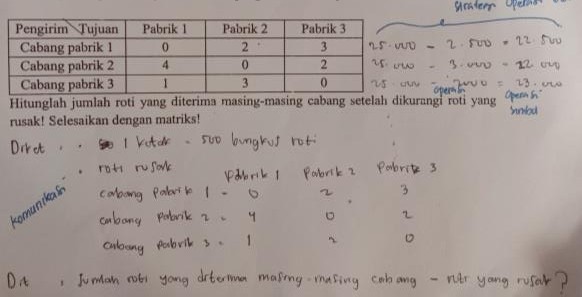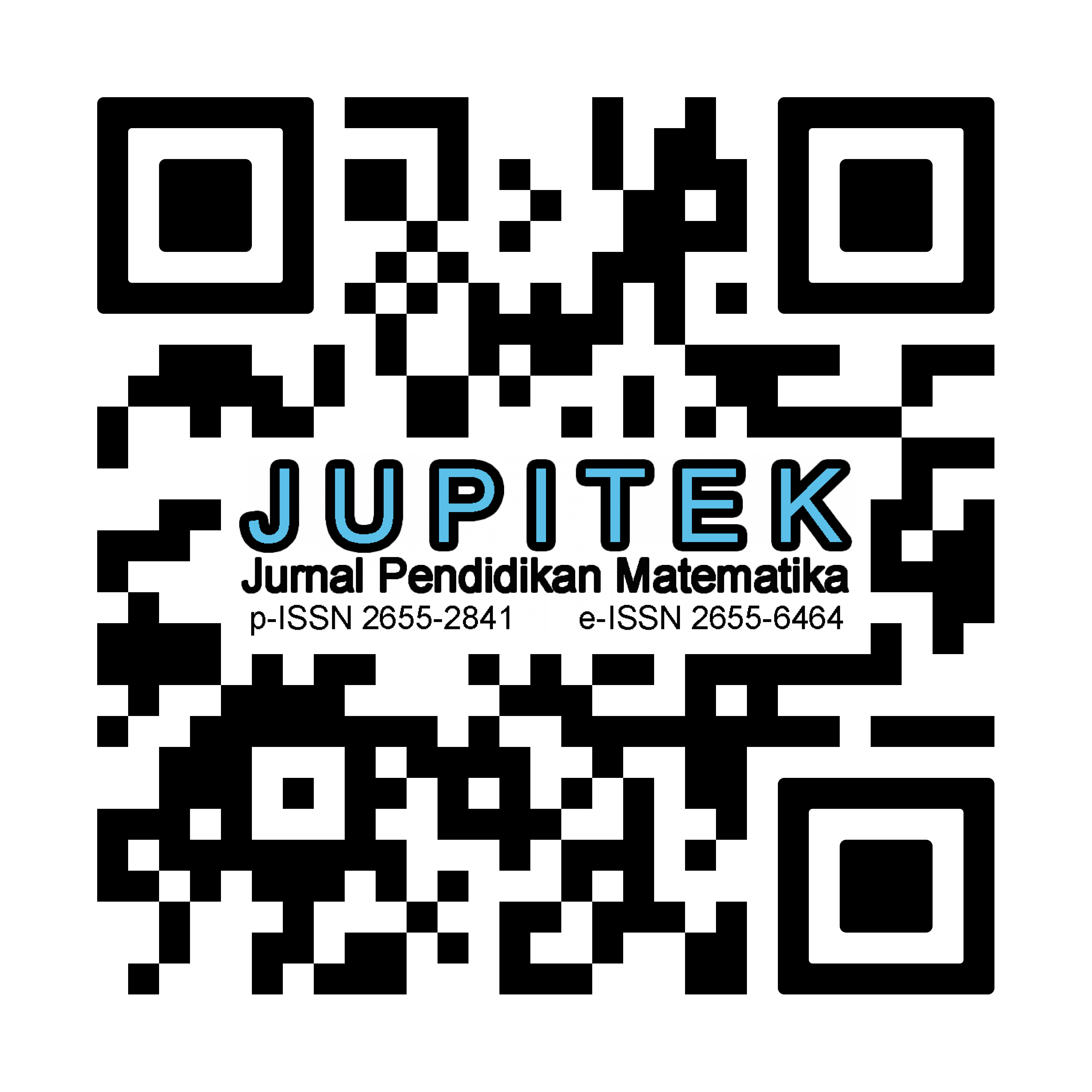STUDENTS' MATHEMATICAL LITERACY IN SOLVING HIGHER ORDER THINKING SKILL PROBLEMS ON MATRIX MATERIAL
Abstract
This qualitative descriptive study aims to describe students' mathematical literacy skills in solving Higher Order Thinking Skills (HOTS) questions on matrix material. The method used in this research is qualitative method. The subjects of this study were 6 students of class XI IPA SMA Al-Azhar Jambi. The instrument used is the initial ability test which contains 5 items, the Higher Order Thinking Skills (HOTS) written test which contains 3 essay questions and interview guidelines. Data analysis techniques include domain, taxonomy and componential analysis. The results of this study are: 1) It shows that all subjects meet the communication indicators (except S6), S1, S2, S3, S4 almost meet the indicators of mathematization, problem solving strategies and the use of formal and symbolic language, technical and operational languages, S5 and S6 do not meet the three indicators, and 2) the factors that affect mathematical literacy skills are: students' perceptions of the importance of mathematics, self-confidence in mathematical abilities, teacher quality in teaching, teacher character in teaching, models, media, strategies, approaches used in teaching, learning, limited time in working, level of HOTS questions and student interest in solving problems.
Downloads
References
Abdussakir. (2018). Literasi Matematis dan Upaya Pengembangannya dalam Pembelajaran di Kelas. Seminar Pendidikan Matematika “Menanamkan Pendidikan Karakter (Akhlaqul Karimah) Dan Kesadaran Literasi Matematika Siswa Melalui Pembelajaran Matematika,” 1–16
Akasah, L. S. S. I., Hilali, H. E., & Asiani, R. W. (2021). Analisis Kesulitan Siswa Dalam Menyelesaikan Soal Pythagoras Pada Siswa Sekolah Menengah Pertama Islam Al-Falah Janji (Doctoral dissertation, UIN Sulthan Thaha Saifuddin Jambi).
Asmara, A. S., Waluya, S. B., & Rochmad, R. (2017). Analisis kemampuan literasi matematika siswa kelas X berdasarkan kemampuan matematika. Scholaria, 7(2), 135-142.
Astuti, P. (2018). Kemampuan Berpikir Tingkat Tinggi. Journal Reseapedia, 1(1), 5–24.
Azhar, L. (2020). Analisis Kemampuan Literasi Matematika Terhadap Materi Sistem Persamaan Linear Dua Variabel Berbasis Hots Pada Siswa Kelas Viii Smp Muhammadiyah 1 Sukoharjo Tahun 2019/2020 (Doctoral dissertation, Universitas Muhammadiyah Surakarta).
Hamidah, L. (2018). Higher Order Thinking Skills: Seni Melatih Kemampuan Berpikir Tingkat Tinggi. Temanggung: Desa Pustaka Indonesia.
Helmawati, S. E. (2020). Pembelajaran Dan Penilaian Berbasis Hots: Higher Order Thinking Skill. Remaja Rosdakarya
Kemendikbud, B. (2019). Pendidikan di Indonesia belajar dari hasil PISA 2018. Pusat Penilaian Pendidikan Balitbang KEMENDIKBUD, 21, 1-206.
Kusniati, I. (2018). Analisis Kemampuan Literasi Matematis Peserta Didik Melalui Penyelesaian Soal-Soal Ekspresi Aljabar Di SMP Negeri 1 Lambu Kibang (Doctoral dissertation, UIN Raden Intan Lampung).
Nugroho, R. A. (2018). HOTS (Kemampuan Berpikir Tingkat Tinggi: Konsep, Pembelajaran, Penilaian, dan Soal-soal). Jakarta: PT Gramedia Widiasarana Indonesia.
Padmadewi, N. N., & Artini, L. P. (2018). Literasi di sekolah, dari teori ke praktik. Nilacakra.
PISA. (2016). Programme For International Student Assessment (PISA) Result From PISA 2015. OECD.
Simamora, K. A. L., & Tilaar, A. L. (2021). Analisis Kemampuan Literasi Matematika Ditinjau Dari Penggunaan Soal-Soal Matematika Tipe HOTS. MARISEKOLA: Jurnal Matematika Riset Edukasi dan Kolaborasi, 2(1), 23-30.
Sugiyono, S. (2016). Metode Penelitian Kuantitatif, Kualitatif, dan R & D (23rd ed.). Alfabeta
Suryapuspitarini, B. K., Wardono, W., & Kartono, K. (2018, February). Analisis soal-soal matematika tipe Higher Order Thinking Skill (HOTS) pada kurikulum 2013 untuk mendukung kemampuan literasi siswa. In PRISMA, Prosiding Seminar Nasional Matematika (Vol. 1, pp. 876-884).
Tarsito, S. (2014). Metode Penelitian Kuantitatif, Kualitatif dan R&D. Alfabeta. Bandung.
Toheri, T., & Muchyidin, A. (2019). Panduan Pelatihan Penyusunan soal HOTS Matematika. CV. Confident.
Widana, Wayan. (2018). Modul Penyusunan Soal Keterampilan Berpikir Tingkat Tinggi (Higher Order Thingking Skills) Matematika). Jakarta: Direktorat Pembinaan Sekolah Menengah Atas.

Copyright (c) 2022 Ili Yanti, Rosi Widia Asiani, Muhammad Kukuh

This work is licensed under a Creative Commons Attribution-NonCommercial-ShareAlike 4.0 International License.
License and Copyright Agreement
By submitting a manuscript to Jurnal Pendidikan Matematika (JUPITEK), the author(s) certify and agree to the following terms:
- Originality and Authority: The submitting author is authorized by all co-authors to enter into this agreement. The manuscript describes original work that has not been published previously in a peer-reviewed journal, nor is it under consideration for publication elsewhere.
- Approval: Its publication has been approved by all author(s) and by the responsible authorities of the institutions where the work was carried out.
- Rights: The authors secure the right to reproduce any material that has already been published or copyrighted elsewhere.
- Licensing and Copyright: Authors retain the copyright to their work.
- License Grant: The authors grant Jurnal Pendidikan Matematika (JUPITEK) the right of first publication, with the work simultaneously licensed under the Creative Commons Attribution-NonCommercial-ShareAlike 4.0 International (CC BY-NC-SA 4.0).
- Self-Archiving: Authors are permitted and encouraged to deposit the published version of their article in institutional repositories, on their personal websites, and other academic platforms, with proper acknowledgment of its initial publication in Jurnal Pendidikan Matematika (JUPITEK).





.png)


